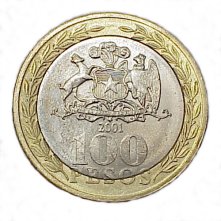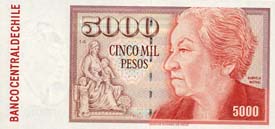|


The peso is the currency of Chile. The current peso has circulated since 1975, with a previous version circulating between 1817 and 1960. The symbol used locally for it is $. The ISO 4217 code for the present peso is CLP. It is subdivided into 100 centavos, although no centavo denominated coins remain in circulation. The average exchange rate of the Chilean Peso to the U.S Dollar was 1 U.S. Dollar to 559.7 Chilean Pesos in 2009.
First peso, 1817-1960
The first Chilean peso was introduced in 1817, at a value of 8 Spanish colonial reales. Until 1851, the peso was subdivided into 8 reales, with the escudo worth 2 pesos. In 1835, copper coins denominated in centavos were introduced but it was not until 1851 that the real and escudo denominations ceased to be issued and further issues in centavos and decimos (worth 10 centavos) commenced. Also in 1851, the peso was set equal 5 French francs on the silver standard, 22.5 grams pure silver. However, gold coins were issued to a different standard to that of France, with 1 peso = 1.37 grams gold (5 francs equalled 1.45 grams gold). In 1885, a gold standard was adopted, pegging the peso to the British pound at a rate of 13? pesos = 1 pound (1 peso = 1 shilling 6 pence). This was reduced in 1926 to 40 pesos = 1 pound (1 peso = 6 pence). From 1925, coins and banknotes were issued denominated in condores, worth 10 pesos. The gold standard was suspended in 1932 and the peso's value fell further. The escudo replaced the peso on January 1, 1960 at a rate 1 escudo = 1000 pesos.
Coins
Between 1817 and 1851, silver coins were issued in denominations of ¼, ½, 1 and 2 reales and 1 peso (also denominated 8 reales), with gold coins for 1, 2, 4 and 8 escudos. In 1835, copper ½ and 1 centavo coins were issued. A full decimal coinage was introduced between 1851 and 1853, consisting of copper ½ and 1 centavo, silver ½ and 1 decimo, 20 and 50 centavos, and 1 peso, and gold 5 and 10 pesos. In 1860, gold 1 peso coins were introduced, followed by cupro-nickel ½, 1 and 2 centavos between 1870 and 1871. Copper coins for these denominations were reintroduced between 1878 and 1883, with copper 2½ centavos added in 1886. A new gold coinage was introduced in 1895, reflecting the lower gold standard, with coins for 2, 5, 10 and 20 pesos. In 1896, the ½ and 1 decimo were replaced by 5 and 10 centavo coins.
In 1907, a short-lived, silver 40 centavo coin was introduced following cessation of production of the 50 centavo coin. In 1919, the last of the copper coins (1 and 2 centavos) were issued. The following year, cupro-nickel replaced silver in the 5, 10 and 20 centavo coins. A final gold coinage was introduced in 1926, in denominations of 20, 50 and 100 pesos. In 1927, silver 2 and 5 peso coins were issued. Cupro-nickel 1 peso coins were introduced in 1933, replacing the last of the silver coins. In 1942, copper 20 and 50 centavos and 1 peso coins were introduced. The last coins of the first peso were issued between 1954 and 1959. These were aluminium 1, 5 and 10 pesos.
Banknotes
The first Chilean paper money was issued between 1840 and 1844 by the treasury of the Province of Valdivia, in denominations of 4 and 8 reales. In the 1870s, a number of private banks began issuing paper money, including the Banco Agricola, the Banco de la Alianza, the Banco de Concepcion, the Banco Consolidaro de Chile, the Banco de A. Edwards y Ca., the Banco de Escobar, Ossa y Ca., the Banco Mobiliario, the Banco Nacional de Chile, the Banco del Pobre, the Banco Sud Americano, the Banco del Sur, the Banco de la Union and the Banco de Valparaiso. Others followed in the 1880s and 1890s. Denominations included 1, 2, 5, 10, 20, 50, 100 and 500 pesos. One bank, the Banco de A. Edwards y Ca., also issued notes denominated in pounds sterling (libra esterlina).
In 1881, the government issued paper money convertible into silver or gold, in denominations of 1, 2, 5, 10, 20, 50, 100 and 1000 pesos. 50 centavo notes were added in 1891 and 500 pesos in 1912. In 1898, provisional issues were made by the government, consisting of private bank notes overprinted with the words "Emision Fiscal". This marked the end of the production of private paper money.
In 1925, the Banco Central de Chile began issuing notes. The first, in denominations of 5, 10, 50, 100 and 1000 pesos, were overprints on government notes. In 1927, notes marked as "Billete Provisional" were issued in denominations of 5, 10, 50, 100, 500 and 1000 pesos. Regular were introduced between 1931 and 1933, in denominations of 1, 5, 10, 20, 50, 100, 500, 1000, 5000 and 10,000 pesos. The 1 and 20 peso notes stopped production in 1943 and 1947, respectively. The remaining denominations continued production until 1959, with a 50,000 peso note added in 1958.
Second peso, 1975-present
The current peso was introduced on September 29, 1975 by decree 1,123; replacing the escudo at a rate of 1 peso = 1000 escudos. It was subdivided into 100 centavos until 1984.
Coins
In 1975, coins were introduced in denominations of 1, 5, 10 and 50 centavos and 1 peso. The 1, 5 and 10 centavo coins were very similar to the 10, 50 and 100 escudo coins they replaced. Since 1983, inflation has left the centavo coins obsolete. 5 and 10 peso coins were introduced in 1976, followed by 50 and 100 pesos in 1981 and 500 pesos in 2000. Coins currently in circulation are in denominations of 1, 5, 10, 50, 100 and 500 pesos; however, most retailers tend to round the prices to the nearest 10 pesos.
Right after the Military Government in Chile (1973-1990), the obverse designs of the 5 and 10 peso coins were changed. Those coins bore the image of a winged female figure wearing a classical robe. She was portrayed as if she had just broken a chain tying her two hands together, since from both of her wrists a piece of chain can be seen hanging. To her side, in small Roman numerals, the date of the coup d'etat is marked, and underneath the word Libertad (Spanish for freedom) is written in capitals. After the return of democracy, a design with the portrait of Bernardo O'Higgins was used. In 2001 a newly redesigned 100 peso coin bearing the image of a Mapuche woman began to circulate.
In February 2010 it was discovered that on the 2008 series of the 50 peso coins the country name "CHILE" had been misspelled as "CHIIE". The national mint said that it did not plan to recall the coins. The coins, worth about 9 cents (US) at the time, subsequently became collectors' items.
Banknotes
In 1976, banknotes were introduced in denominations of 5, 10, 50 and 100 pesos with the reverses of the 5, 10 and 50 peso notes resembling those of the Eº 5000, 10,000 and 50,000 notes they replaced. Inflation has since led to the issue of much higher denominations. 500 peso notes were introduced in May 1977, followed by 1000 pesos in June 1978, 5000 pesos in July 1982, 10,000 pesos in June 1989, 2000 pesos in December 1997 and 20,000 pesos in December 1998. The 5, 10, 50, 100 and 500 peso banknotes have been replaced by coins, leaving the 1000, 2000, 5000, 10,000 and 20,000 peso notes in circulation.
All banknotes are printed on paper with the exception of the 2000 peso note which has been issued as a polymer banknote since September 2004. All banknotes measure 145 x 70 mm (but see exception below).
In commemoration of the bicentennial of the Republic, new banknotes will be released between 2009 and 2012. The first one, of 5,000 peso notes, was released on September 24, 2009 and it was issued as a polymer banknote. The new series of banknotes will have different dimensions from the current, each having a difference of 7 mm depending on their value (1,000 peso note will be smaller than the 5,000 etc.). The new 5,000 peso note is 134 x 70 mm. The new series will keep the current portraits but will have a different look. The reverse will have natural landscapes with a native animal.
This will be the first time a whole new family of banknotes are put into circulation not because of the effects of inflation. The new notes will be more difficult to falsify because of new security measures and cheaper to produce.
In popular culture
Colloquial Chilean Spanish has informal names for some banknotes and coins. These include luka or luca for the thousand-peso banknote, quina for the five-hundred-peso coin (quinientos is Spanish for "five hundred"), and gamba for the hundred-peso coin. These names are old: for example gamba and luca applied to 100 and 1000 escudos before 1975.
Also, some banknotes are called informally by the name of the notable citizen printed on it. For example, the five thousand-peso banknote is sometimes called a gabriela (for Gabriela Mistral), the ten thousand-peso banknote arturo or arturito (for Arturo Prat, arturito meaning "little Arturo"); the one thousand-peso note is frequently referred as luca, meaning a thousand, therefore, the two thousand-peso note can be referred as two luca note, five thousand-peso note as five luca note, ten thousand as ten luca note, 1 million pesos as a guaton or palo, and so on.
Value of the peso
The peso used to be in constant devaluation year on year against the US dollar and other hard currency. However the peso seemed to stabilize against the US dollar in the 1994 to 1997 period, to continue devaluation afterwards with a peak on pesos per US dollar nearing and sometimes surpassing 700 CLP per 1 US dollar in 2002 and 2003 )due to the effects of September 11 attacks on 2001). Since that peak the peso has been revalued significantly.
The text on this page has been made available under the Creative Commons Attribution-ShareAlike License and Creative Commons Licenses
|
